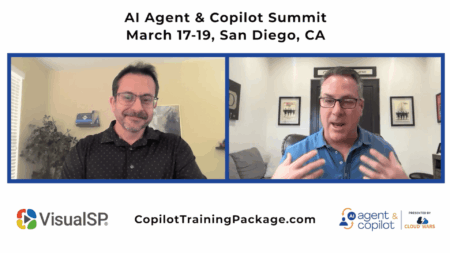Throughout the enterprise cloud’s breakout year of 2018, Microsoft maintained a stranglehold on the #1 spot in my Cloud Wars Top 10 ranking because of its unmatched hybrid-cloud capabilities, its early and intense focus on AI and the intelligent edge as strategic digital-business differentiators, and its unwavering commitment to customer success.
And as Microsoft has an excellent chance of racking up commercial-cloud revenue of more than $32 billion for calendar 2018, it’s essential to understand how the company thinks about its overall strategy: how it positions itself, how it views itself versus competitors, and what its highest-level aspirations are in today’s tumultuous global marketplace.
So here are 10 insights gleaned from Microsoft executive vice-president and CMO Chris Capossela’s remarks at a UBS Investors Conference late last year.

In a Q&A session, Capossela shared candid observations on everything from the company’s longtime focus on the hybrid cloud as the ultimate goal for business customers; why Microsoft doesn’t try to be “the cool kids” in the tech business; the unique thread across the company’s three recent blockbuster acquisitions; and more.
1. The Power of Hybrid Cloud.
“I would love to take credit for it as the marketer but having real product truth when it comes to a cloud platform that does things that the other major cloud platforms don’t do obviously helps tremendously, because when customers see what they can do, in our case the hybrid cloud is really an incredible structural advantage that we have and it’s true differentiation for us…. When we take a business-like Office and move it from a licensed device-based business and make it a cloud subscription that we update monthly, that just changes people’s perception. It’s incredible. More than half of our Office revenue is now done as a subscription product not as a transactional device-oriented license sale anymore.”
2. Customers Like Public Cloud, But They Absolutely Need Hybrid Cloud.
“We don’t think of the public cloud as the end all be all. For us we think there’s a big structural advantage we have around this notion of the hybrid cloud and being the only partner or the only company that can take a customer and allow them to build a private cloud, allow them to build a hybrid cloud and allow them to build a public cloud and manage that spectrum of those three absolutely seamlessly is huge, huge differentiator for us versus our cloud competitors who are sort of born in the cloud and cloud-only and if you want to do your own private data center, or if you want to have a hybrid solution you really have no option, without going to a bunch of third party companies.
“So rather than me thinking about, hey, it’s either Windows Server or it’s Azure, I think of, frankly, Windows Server as your private Azure inside your company. In fact, we have a product called Azure Stack which essentially allows you to take Azure and essentially privatize a lot of it and run it wherever you want to run it. We’re the only company that can do that. And so rather than thinking about, oh, Windows Server is the old thing, instead we say, no, no, no it’s just part of a continuum…. We want to be the partner for you if you need to create a portable data center that goes on cruise ships that connects to the public cloud when it docks, but otherwise when it’s out at sea it’s on its own.”
3. “The More They Use, the More They Pay.”
“One of the most fundamental things that I don’t think people yet understand about Microsoft is we make that mission come true in the business model we’ve moved to, which is a consumption-based business model. We used to be a licensing machine and now we are driven by consumption. And what I mean by consumption is a customer, the more they use the more they pay. They’re only going to use our stuff if they like what it does for them, not surprisingly people have this amazing clarity on if this isn’t working for you I’m going to stop using it.
“And the way we’ve designed the Azure business model and really a subscription model is very based on customer satisfaction with the product and with Microsoft being a good partner to the company. And the only way we succeed is when our customers succeed. And that’s just simply not true of some of our biggest cloud competitors. And I think customers really value that and it feels like a different company because of that. We feel more like a partner to our customers and less like a licensing machine.”
4. Market Expansion: Going Beyond “People Who Work in Carpeted Buildings with Lots of Glass.”
“Office has been very good for people who work in carpeted buildings with lots of glass in them. Office has never been great for people who work in buildings that have concrete floors and are one-story tall or two-stories tall. Think of a manufacturing shop floor, think of airline pilots and people who check people into airlines. Think of Starbucks retail employees, or Best Buy retail employees, these are people who don’t use Word, Excel and PowerPoint as part of their day jobs.
“And so we’ve put a pretty big investment in building new tools for these first-line workers that are available as an Office subscription, but they’re not buying all of the Word, Excel and PowerPoint stuff that the people who work in carpeted buildings typically buy. So first-line workers are one part of our strategy and that is to reach people that Office has never reached. And there’s tons of them in the world.”
5. M&A Strategy: The Power of Networked Communities.
“One of the things that Satya [CEO Satya Nadella] and Amy [CFO Amy Hood] have done very well over the last five years is understand what we are buying when we buy something. And if you look at the acquisitions that we’ve done that I think have been the most successful under their time as CEO and CFO, they’ve been companies that are networks.
“LinkedIn is a network of hundreds of millions of people. Minecraft is a network. You think of it as a game. People think of Minecraft as a game. It’s actually — it’s a massive community of builders. And it happens to be a game. But really the asset is really the network. You look at GitHub; 31 million developers are checking in code or have open source projects in GitHub. It’s a network as much as it is a source code repository. And so we’re very bullish on our ability to welcome GitHub to Microsoft to keep the wonderful things about that community.”
6. Yes, Microsoft Has Become an Open-Source Leader.
“Satya has been on stage multiple times with a slide that says Microsoft loves Linux, Microsoft hearts Linux. Something like 40 percent of the virtual machines that are created on Azure are Linux virtual machines, 40 percent. Something like 50 percent of the Azure workloads are open source workloads. So Azure has become a cloud for open source developers. It’s taken us a while to get past some old tapes that people have about Microsoft and open source. But we’ve moved on.
“We’re the number one contributor to GitHub. Way before we bought GitHub Microsoft was contributing more source code to GitHub than anyone else on the planet. And so people have been watching the company. They’ve seen this change to embrace open source. GitHub is the latest big step that I think a lot of people who would say, oh my gosh, what are they going to do with it? It’s been awesome to see the Microsoft followers respond to those people who would say, oh no, this is terrible, Microsoft hates open source, what’s going to happen. A lot of them have come out and said, no, no, no, that’s old tape, you haven’t seen the new Microsoft. This is a completely different place. They love open source and it’s going to be a very, very good future.”
7. “We’re Never Going To Be the Cool Kids.”
“One of the things we’ve found is truest to our own culture that we want to live, we really want to be an empowerment company. We’re never going to be the cool kids. We’re never going to be the things that a lot of people associate with tech. We’re always
going to want to be the company that empowers others. So that means the customer has to be cool. You celebrate what the customer does, you don’t celebrate what your products do.
“And that’s why if you look at most of our marketing, we’re showcasing customers who have used our technology in some interesting way and allowing them to tell their own story. It’s rare that you’ll see an ad that’s all about our product.”
8. Customer Success Requires Playing the Long Game.
“I noticed that Accenture is going to be speaking later this morning. We’ve been on an incredible journey with Accenture. Today they now have more PCs running Windows 10 than Microsoft does. They have more PCs running Windows 10 than Microsoft does. Now they’re a much bigger company, 450,000 employees and associates. But they have more people on Windows 10 than we do. And they can update Windows 10 as fast as Microsoft can update Windows 10 for our own employees. Now, that took years of work—that didn’t just happen by saying we want to do this. And now you hear them talk very frequently about how they run on Microsoft. That was not a short thing—that took a lot of hard work.”
9. Reinforcing Competitive Boundaries as Digital Business Changes Old Models.
“The key thing is to make sure that we have a great partnership with those ISVs, so they understand where we’re going. We find that when we can do a good job communicating our roadmap to companies that are partners of ours, even as we’re going into areas that our customers want us to go, that may compete in areas they’ve gone, if they know we’re headed there then that typically gives them time to innovate on top of what we’re doing, or understand where our focus is so they can make sure that they continue to add value.
“At times you’re obviously going to compete head-to-head with somebody, but more often than not a lot of the verticalized ISVs that we work closely with always feel like they have room to do things on top of what we’re doing. And that’s important to us to keep those partnerships strong.”
10. Why Marketing Spend as Percentage of Revenue Is Plummeting.
“We have to be smart about the way we spend. Microsoft’s marketing spend as a percent of revenue has come down dramatically over the past six years, and yet even though that’s the case we’ve been able to fund important new marketing initiatives inside of the company that have reaped really nice reward. For us the way I think about it is, we’re going to spend more and more of our marketing dollars on what we would consider performance-based marketing because we’ve gotten our act together as it relates to our data estate.”
Subscribe to the Cloud Wars Newsletter for twice-monthly in-depth analysis of the major cloud vendors from the perspective of business customers. It’s free, it’s exclusive, and it’s great!
*******************
RECOMMENDED READING FROM CLOUD WARS:
The World’s Top 5 Cloud-Computing Suppliers: #1 Microsoft, #2 Amazon, #3 Salesforce, #4 SAP, #5 IBM
Amazon Versus Oracle: The Battle for Cloud Database Leadership
As Amazon Battles with Retailers, Microsoft Leads Them into the Cloud
Why Microsoft Is #1 in the Cloud: 10 Key Insights
SAP’s Stunning Transformation: Qualtrics Already “Crown Jewel of Company”
Watch Out, Microsoft and Amazon: Google Cloud CEO Thomas Kurian Plans To Be #1
The Coming Hybrid Wave: Where Do Microsoft, IBM and Amazon Stand? (Part 1 of 2)
Oracle, SAP and Workday Driving Red-Hot Cloud ERP Growth Into 2019
*********************







